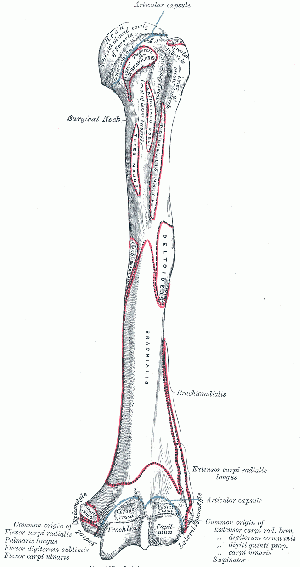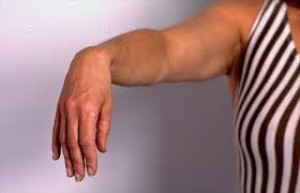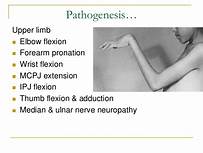Humerus: Difference between revisions
Kim Jackson (talk | contribs) m (corrected reference formatting) |
(Edits and added links to other pages) |
||
| Line 8: | Line 8: | ||
=== Upper Extremity Features === | === Upper Extremity Features === | ||
The head of the humerus is the articular surface of the upper extremity, which is an irregular hemisphere. | The head of the humerus is the proximal articular surface of the upper extremity, which is an irregular hemisphere. It articulates with the glenoid fossa of the [[scapula]]. | ||
The anatomical neck is the part between the head and the tuberosities. | The anatomical neck is the part between the head and the tuberosities. | ||
| Line 14: | Line 14: | ||
The surgical neck is the part between the tuberosities and the shaft. | The surgical neck is the part between the tuberosities and the shaft. | ||
The greater tuberosity it is located lateral to the head. | The greater tuberosity it is located lateral to the head at the proximal end. | ||
The lesser tuberosity is located inferior to the head, on the anterior part of the humerus, Its very prominent and palpable. | The lesser tuberosity is located inferior to the head, on the anterior part of the humerus, Its very prominent and palpable. | ||
Bicipital (intertubercular) groove is located between the two tuberosities. The Biceps tendon is placed here. | Bicipital (intertubercular) groove is located between the two tuberosities. The long head of the [[Biceps Brachii|biceps]] tendon is placed here. | ||
=== Body Features === | === Body Features === | ||
| Line 34: | Line 34: | ||
== Function == | == Function == | ||
The humerus serves as an attachment to 13 muscles which contribute to the movements of the hand and elbow, and therefore the function of the upper limb. | The humerus serves as an attachment to 13 muscles which contribute to the movements of the [[Wrist and Hand|hand]] and [[elbow]], and therefore the function of the upper limb. | ||
==Video== | ==Video== | ||
| Line 41: | Line 41: | ||
== Articulations == | == Articulations == | ||
[[Glenohumeral Joint|Glenohumeral joint]] | [[Glenohumeral Joint|Glenohumeral joint]] | ||
Elbow joint | [[Elbow|Elbow joint]] | ||
== Muscle Attachments == | == Muscle Attachments == | ||
| Line 95: | Line 95: | ||
Proximal end or Head-Surgical Neck Fracture<ref name=":0">Jones O. [https://teachmeanatomy.info/upper-limb/bones/humerus/#Clinical_Relevance_Surgical_Neck_Fracture The Humerus (Updated 16 June 2019). Teach Me Anatomy]. Accessed 24 March 2020</ref> | Proximal end or Head-Surgical Neck Fracture<ref name=":0">Jones O. [https://teachmeanatomy.info/upper-limb/bones/humerus/#Clinical_Relevance_Surgical_Neck_Fracture The Humerus (Updated 16 June 2019). Teach Me Anatomy]. Accessed 24 March 2020</ref> | ||
* It is caused by a direct blow on the area or fall on an outstretched hand. | * It is caused by a direct blow on the area or fall on an outstretched hand. | ||
* It | * It can result in damage to the [[Axillary Nerve Injury|Axillary nerve]] and [[Arteries|Posterior circumflex artery]]. | ||
* Axillary nerve damage results in paralysis of deltoid and teres minor muscles. | * Axillary nerve damage results in paralysis of [[deltoid]] and [[Teres Minor|teres minor]] muscles. | ||
Shaft-Mid-shaft fracture<ref name=":0" /> | Shaft-Mid-shaft fracture<ref name=":0" /> | ||
* This fracture causes damage to radial nerve and Profunda brachii artery. | * This fracture causes damage to [[Radial Nerve|radial nerve]] and Profunda brachii artery. | ||
* Sensory loss can be seen over the dorsal surface of the hand, proximal parts of lateral 3 and a half fingers dorsally. | * Sensory loss can be seen over the dorsal surface of the hand, proximal parts of lateral 3 and a half fingers dorsally. | ||
[[File:Fig1 Wrist Drop.jpg|thumb|Wrist drop]] | |||
* Radial nerve palsy results in wrist drop.[[File:Fig1 Wrist Drop.jpg|thumb|Wrist drop]] | |||
Distal end-Supracondylar fracture<ref name=":0" /> | Distal end-Supracondylar fracture<ref name=":0" /> | ||
* It is a fracture of the distal humerus just above the | * It is a fracture of the distal humerus just above the elbow joint. | ||
* | *It results in damage to the brachial artery and [[Anterior Interosseous Nerve|anterior interosseous nerve]], the resulting ischemia causes [[Volkmann's Contracture|Volkmann's ischaemic contracture]].[[File:Volkmanns contracture.jpg|thumb|Volkmann's Contracture]] | ||
Other conditions | Other conditions | ||
* Humerus Varus can be caused due to haematologic, infectious, genetic and neurological disorders.<ref name=":1">Mostafa E, Varacallo M. [https://www.ncbi.nlm.nih.gov/books/NBK534821/# Anatomy, Shoulder and Upper Limb, Humerus]. InStatPearls [Internet] 2018 Dec 3. Accessed 26 March 2020</ref> | * Humerus Varus can be caused due to haematologic, infectious, genetic and neurological disorders.<ref name=":1">Mostafa E, Varacallo M. [https://www.ncbi.nlm.nih.gov/books/NBK534821/# Anatomy, Shoulder and Upper Limb, Humerus]. InStatPearls [Internet] 2018 Dec 3. Accessed 26 March 2020</ref> | ||
Revision as of 22:04, 25 June 2022
Description[edit | edit source]
The humerus is a long bone which consists of a shaft (diaphysis) and two extremities (epiphysis). It is the longest bone of the upper extremity.
Structure[edit | edit source]
Upper Extremity Features[edit | edit source]
The head of the humerus is the proximal articular surface of the upper extremity, which is an irregular hemisphere. It articulates with the glenoid fossa of the scapula.
The anatomical neck is the part between the head and the tuberosities.
The surgical neck is the part between the tuberosities and the shaft.
The greater tuberosity it is located lateral to the head at the proximal end.
The lesser tuberosity is located inferior to the head, on the anterior part of the humerus, Its very prominent and palpable.
Bicipital (intertubercular) groove is located between the two tuberosities. The long head of the biceps tendon is placed here.
Body Features[edit | edit source]
The body of the humerus has three borders and three surfaces.
Borders[edit | edit source]
- Anterior
- Lateral
- Medial
Surfaces[edit | edit source]
- Antero-lateral
- Antero-medial
- Posterior
Function[edit | edit source]
The humerus serves as an attachment to 13 muscles which contribute to the movements of the hand and elbow, and therefore the function of the upper limb.
Video[edit | edit source]
Articulations[edit | edit source]
Muscle Attachments[edit | edit source]
| Muscle | Attachment |
|---|---|
| Supraspinatus | Greater Tubercle |
| Infraspinatus | Greater Tubercle |
| Teres Minor | Greater Tubercle
Upper Part of the Lateral Border |
| Subscapularis | Lesser Tubercle |
| Pectoralis Major | Upper Part of the Anterior Border |
| Triceps Brachii | Lower Part of the Lateral Border
Lateral Supracondylar Ridge |
| Brachioradialis | Lateral Supracondylar Ridge |
| Extensor Carpi Radialis Longus | Lateral Supracondylar Ridge |
| Teres Major | Crest of the Lesser Tubercle |
| Coracobrachialis | Crest of the Lesser Tubercle |
| Brachialis | Medial Supracondylar Ridge |
| Pronator Teres | Medial Supracondylar Ridge |
| Latissimus Dorsi | Bicipital Groove |
Clinical Relevance[edit | edit source]
Proximal end or Head-Surgical Neck Fracture[2]
- It is caused by a direct blow on the area or fall on an outstretched hand.
- It can result in damage to the Axillary nerve and Posterior circumflex artery.
- Axillary nerve damage results in paralysis of deltoid and teres minor muscles.
Shaft-Mid-shaft fracture[2]
- This fracture causes damage to radial nerve and Profunda brachii artery.
- Sensory loss can be seen over the dorsal surface of the hand, proximal parts of lateral 3 and a half fingers dorsally.
- Radial nerve palsy results in wrist drop.
Distal end-Supracondylar fracture[2]
- It is a fracture of the distal humerus just above the elbow joint.
- It results in damage to the brachial artery and anterior interosseous nerve, the resulting ischemia causes Volkmann's ischaemic contracture.
Other conditions
- Humerus Varus can be caused due to haematologic, infectious, genetic and neurological disorders.[3]
- Charcot arthropathy is a rare disorder characterised by debilitating joint destruction.[3]
References[edit | edit source]
- ↑ Gray H. Anatomy of the human body [Internet]. 20th ed. Lewis WH, editor. Philadelphia: Lea & Febiger; 1918. Accessed 26 March 2020.
- ↑ 2.0 2.1 2.2 Jones O. The Humerus (Updated 16 June 2019). Teach Me Anatomy. Accessed 24 March 2020
- ↑ 3.0 3.1 Mostafa E, Varacallo M. Anatomy, Shoulder and Upper Limb, Humerus. InStatPearls [Internet] 2018 Dec 3. Accessed 26 March 2020









